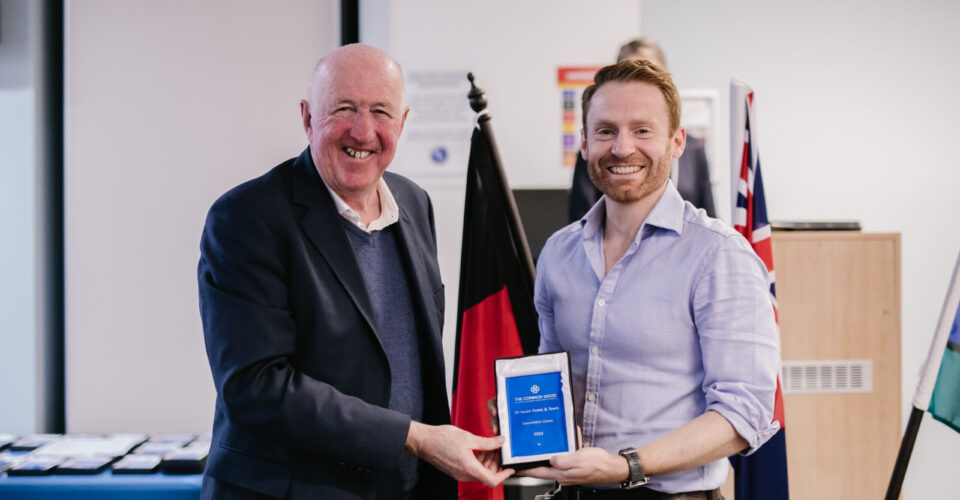“Trikafta has transformed the lives of people with Cystic Fibrosis—not just in terms of clinical outcomes but also quality of life, which is significantly better than it was previously. However, Trikafta does come with potentially serious side effects—some more concerning than others,” said Dr Evans.
Currently, at least 85 per cent of people living with Cystic Fibrosis (pwCF) are eligible for the medication Trikafta® (elexacaftor/tezacaftor/ivacaftor), which became available through the Pharmaceutical Benefits Scheme (PBS) in Australia in 2022. It is anticipated that this will increase up to 90 per cent soon. While Trikafta has significantly improved clinical outcomes and quality of life for many, there is still much to learn about its side effects and how it interacts with other medications. As a result, Thoracic Physician Dr Ieuan Evans is working to develop a Therapeutic Drug Monitoring (TDM) program specifically for Trikafta.
Dr Evans explained that existing data on the pharmacokinetics and pharmacodynamics (PK/PD) of the three components of Trikafta—elexacaftor, tezacaftor, and ivacaftor—is limited for pwCF.
“For certain individuals, it’s hard to know if we’re dosing them correctly, especially when adjustments are needed due to side effects, comorbidities, or other medications,” Dr Evans said. “TDM could enable precision-guided therapy that reduces toxicity while maximizing clinical benefit.”
Despite its promise, many unanswered questions remain.
“We have patients who had to stop Trikafta temporarily and then restart it at a lower or gradually increasing dose. But we don’t know if that reintroduction provides therapeutic benefit or merely exposes them to side effects with limited gains,” he said. “Some patients take medications such as immunosuppressants that potentially interact with Trikafta, with others needing dose adjustments because of liver toxicity – but do these types of dose reduction mean they are getting enough of the drug to see a significant benefit?”
Dr Evans also raised questions about whether other cystic fibrosis treatments should be reduced or discontinued after starting Trikafta.
“We simply don’t know if that’s the right course of action yet,” he added.
Dr Evans and his collaborators are using NATA-accredited assays, developed by Pathology Queensland, to establish the TDM program. This involves taking blood samples from pwCF to measure the levels of all three Trikafta components. Although the program is still in development, it has been applied in isolated clinical cases, including one published in the paper: The complexities of elexacaftor/tezacaftor/ivacaftor therapeutic drug monitoring in a person with cystic fibrosis and Mycobacterium abscessus pulmonary disease.
In that case, the patient was undergoing complex antibiotic treatment for Mycobacterium abscessus, including rifabutin and clofazimine. These drugs raised concerns about altered hepatic metabolism of Trikafta. Blood testing confirmed that these medications lowered the concentrations of all three components of Trikafta. Nonetheless, the patient showed significant clinical improvement, highlighting the complex and often unpredictable nature of drug interactions and the need for better understanding of how blood levels correlate with treatment outcomes.
“This case demonstrated both the potential value of TDM in guiding therapy and the pressing need for more data on how drug-to-drug interactions or dose modifications affect efficacy,” said Dr Evans.
Beyond Trikafta, Dr Evans also contributes to research through his work across the hospital’s general thoracic service, Adult Cystic Fibrosis Centre, and non-tuberculous mycobacterial service. His research particularly focuses on bronchiectasis and the treatment of Mycobacterium abscessus.
“My PhD research aimed to optimise treatment options for Mycobacterium abscessus, a growing concern in pwCF and individuals with bronchiectasis,” he explained. “During my PhD, we developed a nebulised acidified nitrate solution that completely eradicated the bacteria in vitro. It outperformed any combination of antibiotics I had previously tested.”
Although translating lab success into clinical practice is always challenging, the solution performed well in a mouse model in the United States and has since entered a clinical trial to assess its potential in human patients.
“To have something go from a lab experiment during my PhD to a clinical trial exceeded all my expectations,” Dr Evans said.








